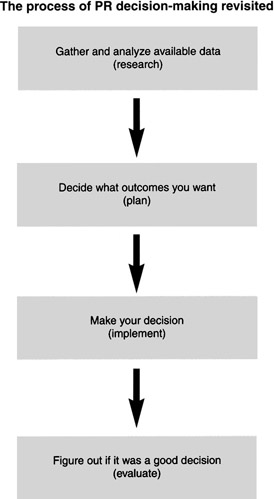DECISION STEPS
In public relations practice, we base our strategic approaches on a careful process which has four steps (see Figure 15.1):
The process of PR decision-making revisited

Figure 15.1: The process of PR decision-making revisited
-
a research phase consisting of collecting all pertinent data, analysing it and determining the problems;
-
a planning phase where one of the main tasks is to determine what we want to accomplish (objectives) and figure out the best way to accomplish it;
-
an implementation phase where we carry out the strategies and tactics we figured out in the planning phase; and
-
an evaluation phase where we figure out if our plan actually accomplished what we set out to do and more.
Making ethical decisions is a bit easier if we consider the phases that are similar to the above:
-
The research phase in ethical decision-making is similar to the data collection and analysis that we do in the PR planning process. The tricky part is recognizing that we are facing an ethical issue in the first place. Figure 15.2 suggests using the ˜PR pillars that we discussed in Chapter 2.
Recognizing an ethical issue using the ˜PR Pillars
| |
-
Is there harm involved?
-
Is there a missed opportunity to do something good?
-
Could anyone be misled in any way?
-
Will anyone's privacy be invaded?
-
Is it unfair to anyone?
-
Does it feel wrong?
| |
Figure 15.2: Recognizing an ethical issue using the ˜PR Pillars
Once you recognize that, indeed, an ethical issue is part of the situation that faces you, you need to gather as much information as possible about the following:
-
how the situation developed in the first place;
-
who are the involved parties on both sides of the situation;
-
what current issues are affecting the situation.
-
The planning phase in making ethical decisions forces us to examine the outcomes we want, but also to consider the outcomes that are likely, given the choices available. This is where we can use what has come to be known in ethics circles as ˜The Potter Box. This decision-making model was developed by Harvard divinity professor Ralph Potter and is now widely accepted as an organized approach to considering the application of values, principles and loyalties to making defensible ethical decisions (more about how to apply this approach a bit later).

Figure 15.3: The ˜Potter BoxOnce we know from our data collection and analysis that there is an ethical issue, we define it. The next step is to determine the values that we bring to bear on the situation. Then we apply selected principles to the situation and consider to whom we have duties . All of this should lead us to the next step in the process.
-
The next step in making the decision is to actually make it, but this is where our ethical decision-making differs slightly from our PR process decisions. Rather than moving immediately to implementation, we move directly to a hypothetical version of the final phase. Implementation comes later.
-
The final phase is to evaluate the decision to determine if it is a good one. This is where a second guess comes into play. But the second guess is accomplished before the first guess is carried through.
EAN: 2147483647
Pages: 165